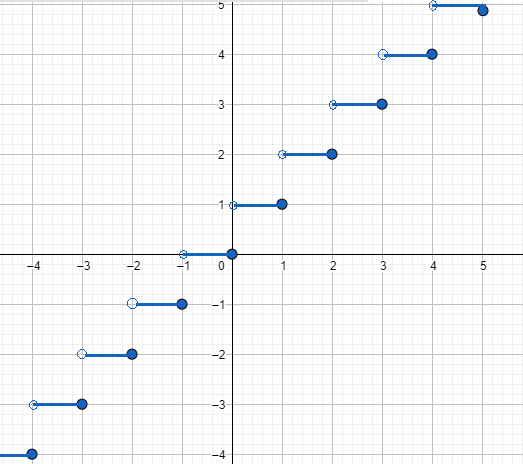
The solution set of ${\left( x \right)^2} + {\left( {x + 1} \right)^2} = 25$ , where (x) denotes the nearest integer greater or equal to x is
A. [-4,3)$ \cup $ [3,4)
B. (-5,-4] $ \cup $ (2,3]
C. (2,4)
D. None of these
Answer
576.6k+ views
Hint: First we’ll assume (x) with an integer variable, then we’ll get a quadratic equation in that variable, on solving that equation we’ll have its value. With the help of those solutions, we’ll conclude the interval of x as obtaining the solution of those equations will give us the value of (x) but we have to find the value of x.
Complete step by step answer:
Given data: ${\left( x \right)^2} + {\left( {x + 1} \right)^2} = 25..............(i)$
Now, it is given that (x) is the least integer function that gives only integer value.
Let $\left( x \right) = t$, where t is an integer.
Therefore, $\left( {x + 1} \right) = t + 1$
Now, substituting the value of ${\left( x \right)^2}$and ${\left( {x + 1} \right)^2}$in equation(i),
i.e. ${t^2} + {\left( {t + 1} \right)^2} = 25$
On expanding the square term,
$ \Rightarrow {t^2} + {t^2} + 1 + 2t = 25$
$ \Rightarrow {t^2} + {t^2} + 1 + 2t - 25 = 0$
Solving for the like terms
$ \Rightarrow 2{t^2} + 2t - 24 = 0$
Dividing the whole equation by 2
$ \Rightarrow {t^2} + t - 12 = 0$
Now, splitting the coefficient of t such that they will be factors of ${t^2}$and the constant term
$ \Rightarrow {t^2} + (4 - 3)t - 12 = 0$
Now, simplifying the brackets,
$ \Rightarrow {t^2} + 4t - 3t - 12 = 0$
Taking common from the first two and last two terms,
$ \Rightarrow t(t + 4) - 3(t + 4) = 0$
Taking (t+4) common from both the terms,
$ \Rightarrow (t + 4)(t - 3) = 0$
i.e. $t + 4 = 0$ or $t - 3 = 0$
Therefore, $t = - 4$ or $t = 3$
When $t = - 4$
i.e. $(x) = - 4$
since (x) is the integer greater or equal to x
$\therefore x \in ( - 5, - 4]$
Similarly, when $t = 3$
i.e. $(x) = 3$
$\therefore x \in (2,3]$
Combining the values of x, we get
That $x \in ( - 5, - 4] \cup (2,3]$
Option(B) is correct
Note: In the given solution we’ve talked about the least integer function (x). let us draw a graph of the least integer function for a better understanding of this function.

So from the graph, we can say that if the value of $x \in (2,3]$ then the value of (x) (denotes the nearest integer greater or equal to x) is 3.
Complete step by step answer:
Given data: ${\left( x \right)^2} + {\left( {x + 1} \right)^2} = 25..............(i)$
Now, it is given that (x) is the least integer function that gives only integer value.
Let $\left( x \right) = t$, where t is an integer.
Therefore, $\left( {x + 1} \right) = t + 1$
Now, substituting the value of ${\left( x \right)^2}$and ${\left( {x + 1} \right)^2}$in equation(i),
i.e. ${t^2} + {\left( {t + 1} \right)^2} = 25$
On expanding the square term,
$ \Rightarrow {t^2} + {t^2} + 1 + 2t = 25$
$ \Rightarrow {t^2} + {t^2} + 1 + 2t - 25 = 0$
Solving for the like terms
$ \Rightarrow 2{t^2} + 2t - 24 = 0$
Dividing the whole equation by 2
$ \Rightarrow {t^2} + t - 12 = 0$
Now, splitting the coefficient of t such that they will be factors of ${t^2}$and the constant term
$ \Rightarrow {t^2} + (4 - 3)t - 12 = 0$
Now, simplifying the brackets,
$ \Rightarrow {t^2} + 4t - 3t - 12 = 0$
Taking common from the first two and last two terms,
$ \Rightarrow t(t + 4) - 3(t + 4) = 0$
Taking (t+4) common from both the terms,
$ \Rightarrow (t + 4)(t - 3) = 0$
i.e. $t + 4 = 0$ or $t - 3 = 0$
Therefore, $t = - 4$ or $t = 3$
When $t = - 4$
i.e. $(x) = - 4$
since (x) is the integer greater or equal to x
$\therefore x \in ( - 5, - 4]$
Similarly, when $t = 3$
i.e. $(x) = 3$
$\therefore x \in (2,3]$
Combining the values of x, we get
That $x \in ( - 5, - 4] \cup (2,3]$
Option(B) is correct
Note: In the given solution we’ve talked about the least integer function (x). let us draw a graph of the least integer function for a better understanding of this function.

So from the graph, we can say that if the value of $x \in (2,3]$ then the value of (x) (denotes the nearest integer greater or equal to x) is 3.
Recently Updated Pages
Master Class 9 General Knowledge: Engaging Questions & Answers for Success

Master Class 9 English: Engaging Questions & Answers for Success

Master Class 9 Science: Engaging Questions & Answers for Success

Class 9 Question and Answer - Your Ultimate Solutions Guide

Master Class 8 Maths: Engaging Questions & Answers for Success

Class 8 Question and Answer - Your Ultimate Solutions Guide

Trending doubts
Which places in India experience sunrise first and class 9 social science CBSE

Fill the blanks with the suitable prepositions 1 The class 9 english CBSE

Write the 6 fundamental rights of India and explain in detail

Difference Between Plant Cell and Animal Cell

What is pollution? How many types of pollution? Define it

What is the Full Form of ISI and RAW





